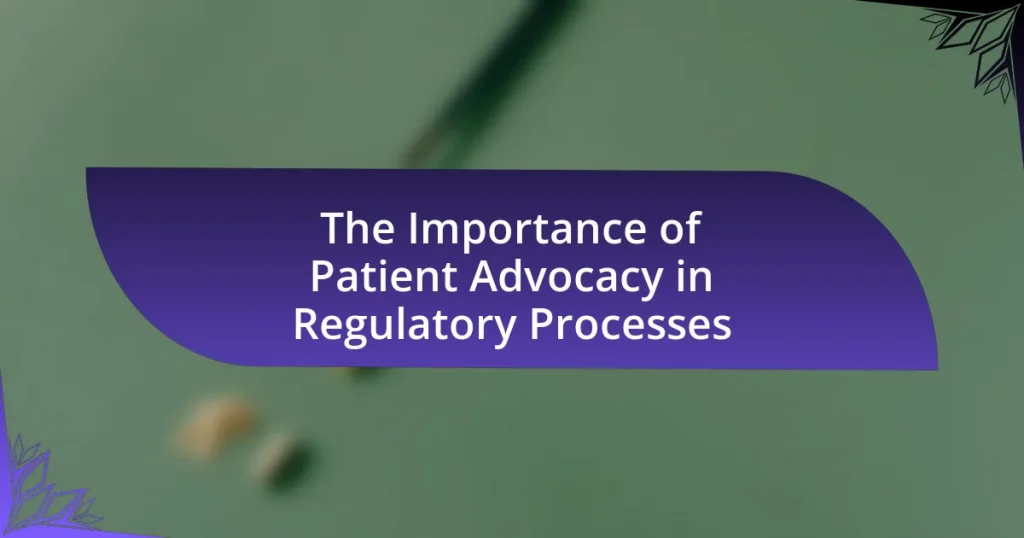Accelerated Approval Pathways for Breakthrough Immunotherapies are regulatory mechanisms established by the U.S. Food and Drug Administration (FDA) to expedite the approval of therapies that show significant potential in treating serious conditions. These pathways allow for earlier approval based on preliminary evidence, such as surrogate endpoints, rather than waiting for comprehensive clinical trial data. The article outlines the differences between accelerated and traditional approval processes, the criteria for qualifying therapies, the role of clinical trials, and the importance of post-marketing studies. It also discusses the implications for patient access, potential risks, and the challenges faced in the approval process, providing a comprehensive overview of how these pathways impact the development and availability of innovative immunotherapies.

What are Accelerated Approval Pathways for Breakthrough Immunotherapies?
Accelerated Approval Pathways for Breakthrough Immunotherapies are regulatory mechanisms established by the U.S. Food and Drug Administration (FDA) to expedite the approval process for therapies that demonstrate significant potential in treating serious conditions. These pathways allow for earlier approval based on preliminary evidence suggesting that the drug may provide a meaningful benefit over existing treatments. For instance, the FDA can grant accelerated approval based on surrogate endpoints, which are indirect measures of clinical benefit, rather than waiting for definitive evidence from large-scale clinical trials. This approach has been utilized for various immunotherapies, significantly reducing the time it takes for patients to access potentially life-saving treatments.
How do these pathways differ from traditional approval processes?
Accelerated approval pathways differ from traditional approval processes by allowing for faster access to therapies based on preliminary evidence of efficacy rather than full clinical trial data. Traditional approval processes typically require comprehensive data from multiple phases of clinical trials to demonstrate safety and effectiveness before a drug can be marketed. In contrast, accelerated pathways, such as the FDA’s Breakthrough Therapy designation, enable sponsors to submit data from early-phase trials, which can expedite the review process and facilitate earlier patient access to promising treatments. This approach is supported by the FDA’s commitment to addressing unmet medical needs, as evidenced by the increased number of drugs approved through these pathways, which rose significantly from 2012 to 2021, highlighting their effectiveness in bringing innovative therapies to market more swiftly.
What criteria must be met for a therapy to qualify for accelerated approval?
A therapy must demonstrate that it treats a serious condition and provides a meaningful advantage over existing treatments to qualify for accelerated approval. Specifically, the therapy should show preliminary evidence of effectiveness, which may include data from early-phase clinical trials indicating that the therapy has the potential to improve outcomes for patients. The U.S. Food and Drug Administration (FDA) outlines these criteria to expedite the availability of therapies that address unmet medical needs, thereby allowing patients access to potentially life-saving treatments sooner than traditional approval processes would permit.
What role do clinical trials play in the accelerated approval process?
Clinical trials are essential in the accelerated approval process as they provide critical evidence of a drug’s efficacy and safety. The U.S. Food and Drug Administration (FDA) utilizes data from these trials to evaluate whether a treatment demonstrates a significant benefit over existing therapies, allowing for earlier access to promising therapies for serious conditions. For instance, the FDA’s accelerated approval pathway often relies on surrogate endpoints from clinical trials, which can predict clinical benefit, thereby expediting the approval process while still ensuring that the treatment is effective and safe for patients.
Why are accelerated approval pathways important for immunotherapies?
Accelerated approval pathways are crucial for immunotherapies because they enable faster access to potentially life-saving treatments for patients with serious conditions. These pathways allow for the approval of drugs based on early evidence of efficacy, rather than waiting for the completion of lengthy clinical trials. For instance, the FDA’s accelerated approval program has facilitated the introduction of several immunotherapies for cancer, significantly reducing the time from development to patient access. This expedited process is particularly important in oncology, where timely intervention can greatly impact survival rates, as seen with therapies like pembrolizumab, which received accelerated approval based on early trial results demonstrating significant tumor response rates.
How do these pathways impact patient access to new treatments?
Accelerated approval pathways significantly enhance patient access to new treatments by allowing therapies to reach the market more quickly based on preliminary evidence of efficacy. These pathways, such as the FDA’s Breakthrough Therapy designation, enable faster review processes and reduced clinical trial requirements, which can lead to earlier availability of innovative immunotherapies for patients with serious conditions. For instance, the FDA approved the CAR T-cell therapy Kymriah in 2017 under the accelerated approval pathway, providing treatment options for patients with refractory B-cell acute lymphoblastic leukemia, a previously hard-to-treat condition. This expedited access can be crucial for patients who have exhausted other treatment options, demonstrating the pathways’ role in improving timely access to potentially life-saving therapies.
What are the potential risks associated with accelerated approvals?
The potential risks associated with accelerated approvals include inadequate assessment of safety and efficacy, leading to the possibility of harmful side effects or ineffective treatments being made available to patients. Accelerated approval pathways allow drugs to reach the market based on preliminary evidence, which may not fully capture long-term outcomes or rare adverse events. For instance, a study published in the Journal of the American Medical Association found that approximately 30% of drugs approved through accelerated pathways later faced safety issues or were withdrawn from the market due to insufficient efficacy data. This highlights the critical need for ongoing post-marketing studies to monitor the long-term effects of these therapies.

What are the key components of the accelerated approval process?
The key components of the accelerated approval process include the use of surrogate endpoints, the requirement for post-marketing studies, and the FDA’s ability to expedite the review timeline. Surrogate endpoints are indicators that can predict clinical benefit, allowing drugs to be approved based on early evidence of effectiveness rather than traditional endpoints like overall survival. Post-marketing studies are mandated to confirm the drug’s clinical benefit after approval. The FDA can also prioritize applications and reduce review times for drugs that address unmet medical needs, facilitating quicker access to potentially life-saving therapies.
What types of evidence are required for accelerated approval?
Accelerated approval requires evidence that demonstrates a drug’s effect on a surrogate endpoint that is reasonably likely to predict clinical benefit. This evidence typically includes data from early-phase clinical trials, which may show a significant effect on tumor response rates or progression-free survival. The Food and Drug Administration (FDA) emphasizes that the surrogate endpoints must be validated and relevant to the disease being treated, as seen in the approval of therapies for conditions like cancer where traditional endpoints may take longer to assess.
How is surrogate endpoint data utilized in the approval process?
Surrogate endpoint data is utilized in the approval process by providing a substitute measure that predicts clinical benefit, allowing for faster regulatory decisions. Regulatory agencies, such as the FDA, accept surrogate endpoints when they are scientifically validated to correlate with actual patient outcomes, thereby enabling quicker access to potentially life-saving therapies. For instance, in oncology, tumor response rates are often used as surrogate endpoints to expedite the approval of new cancer treatments, as demonstrated by the accelerated approval of pembrolizumab for certain types of cancer based on tumor response rather than overall survival data.
What is the significance of post-marketing studies in this context?
Post-marketing studies are significant in the context of accelerated approval pathways for breakthrough immunotherapies because they provide essential data on the long-term safety and efficacy of these treatments after they have been approved for public use. These studies help to monitor real-world outcomes, identify rare adverse effects, and ensure that the benefits of the therapies continue to outweigh the risks. For instance, the FDA mandates post-marketing studies to gather additional evidence that can confirm the initial findings from clinical trials, thereby enhancing the overall understanding of the therapy’s performance in diverse patient populations. This ongoing evaluation is crucial for maintaining public trust and ensuring that breakthrough therapies deliver on their promise of improved patient outcomes.
How do regulatory agencies evaluate breakthrough immunotherapies?
Regulatory agencies evaluate breakthrough immunotherapies through a rigorous process that includes assessing clinical trial data, safety profiles, and efficacy outcomes. The U.S. Food and Drug Administration (FDA) employs the Breakthrough Therapy Designation, which expedites the development and review of therapies that show substantial improvement over existing treatments for serious conditions. This designation allows for more frequent interactions between the agency and developers, facilitating a streamlined review process. Additionally, the FDA requires evidence from clinical trials demonstrating that the immunotherapy provides a meaningful benefit to patients, often using endpoints that reflect patient outcomes. The evaluation process is supported by guidelines that emphasize the importance of real-world evidence and post-marketing studies to ensure ongoing safety and effectiveness.
What role does the FDA play in the accelerated approval of immunotherapies?
The FDA plays a crucial role in the accelerated approval of immunotherapies by providing a regulatory pathway that allows for the expedited review of drugs that treat serious conditions and fill an unmet medical need. This process enables manufacturers to submit data from early-stage clinical trials, demonstrating that the therapy has a meaningful benefit over existing treatments, rather than waiting for the completion of larger, more extensive trials. For instance, the FDA’s accelerated approval program has been instrumental in the approval of several immunotherapies for cancer, such as pembrolizumab and nivolumab, which were granted accelerated approval based on early evidence of efficacy. This approach is supported by the FDA’s commitment to facilitating access to innovative therapies while ensuring that safety and effectiveness standards are maintained.
How do international regulatory bodies approach accelerated approvals?
International regulatory bodies, such as the FDA in the United States and the EMA in Europe, approach accelerated approvals by implementing pathways that allow for faster access to therapies that address unmet medical needs. These bodies evaluate preliminary clinical data to determine if the benefits of a treatment outweigh the risks, enabling quicker market entry for promising therapies. For instance, the FDA’s Breakthrough Therapy designation expedites development and review processes, while the EMA’s Conditional Marketing Authorization allows for approval based on less comprehensive data, provided that further studies are conducted post-approval. This approach is supported by the need for timely access to innovative treatments, particularly in areas like oncology and rare diseases, where traditional approval timelines may delay patient access to potentially life-saving therapies.

What challenges are faced in the accelerated approval of breakthrough immunotherapies?
The challenges faced in the accelerated approval of breakthrough immunotherapies include uncertainty in clinical efficacy, limited patient population data, and the need for post-marketing studies to confirm long-term benefits and safety. Uncertainty arises because accelerated approval often relies on surrogate endpoints rather than direct measures of clinical benefit, which can lead to questions about the actual effectiveness of the therapy. Limited data from diverse patient populations can hinder the generalizability of results, making it difficult to assess how well the therapy will perform across different demographics. Additionally, regulatory agencies frequently require post-marketing studies to gather further evidence, which can delay access to therapies and complicate the approval process.
What are common obstacles in the clinical trial phases?
Common obstacles in the clinical trial phases include recruitment challenges, regulatory hurdles, and funding limitations. Recruitment challenges arise when there is difficulty in finding eligible participants, which can delay trial timelines. Regulatory hurdles often involve navigating complex approval processes and meeting stringent safety and efficacy standards set by agencies like the FDA. Funding limitations can restrict the resources available for conducting trials, impacting the scope and duration of research. These obstacles can significantly affect the overall success and efficiency of clinical trials, particularly in the context of accelerated approval pathways for breakthrough immunotherapies.
How do patient recruitment and retention affect trial outcomes?
Patient recruitment and retention significantly influence trial outcomes by determining the sample size and the quality of data collected. High recruitment rates ensure that trials meet their enrollment targets, which is essential for statistical power and generalizability of results. Retention of participants throughout the trial duration is crucial, as dropouts can lead to biased results and affect the integrity of the data. For instance, a study published in the Journal of Clinical Oncology found that trials with higher retention rates had more reliable outcomes, demonstrating that effective recruitment and retention strategies directly correlate with the success and validity of clinical trials.
What are the implications of trial design on approval success?
Trial design significantly impacts approval success by influencing the robustness of evidence generated regarding a treatment’s efficacy and safety. Well-structured trials, such as randomized controlled trials, provide high-quality data that regulatory agencies, like the FDA, require for approval. For instance, the FDA’s Accelerated Approval Pathway allows for earlier approval based on surrogate endpoints, but this necessitates rigorous trial designs to ensure that the surrogate accurately predicts clinical benefit. Historical examples, such as the approval of pembrolizumab for melanoma, demonstrate that innovative trial designs can lead to successful outcomes when they effectively address regulatory requirements and patient needs.
How can stakeholders navigate the complexities of accelerated approval?
Stakeholders can navigate the complexities of accelerated approval by actively engaging in early and continuous dialogue with regulatory agencies. This engagement allows stakeholders to understand the specific requirements and expectations for data submission, which is crucial for demonstrating the safety and efficacy of breakthrough immunotherapies. For instance, the FDA’s guidance on accelerated approval emphasizes the importance of robust clinical trial designs and the use of surrogate endpoints, which can expedite the review process. By aligning their development strategies with these regulatory frameworks, stakeholders can effectively manage the challenges associated with accelerated approval, ensuring that their therapies reach patients more swiftly while maintaining compliance with regulatory standards.
What strategies can companies employ to enhance their chances of success?
Companies can enhance their chances of success by leveraging accelerated approval pathways for breakthrough immunotherapies. These pathways, established by regulatory agencies like the FDA, allow for faster review and approval of therapies that address unmet medical needs, thereby reducing time to market. For instance, the FDA’s Breakthrough Therapy designation expedites the development and review process, which can lead to earlier patient access and potentially higher market share. Additionally, companies can engage in early and continuous dialogue with regulatory bodies to align on clinical trial designs and endpoints, ensuring that their products meet the necessary criteria for expedited approval. This strategic approach not only increases the likelihood of successful product launches but also enhances the overall competitiveness of the company in the rapidly evolving biopharmaceutical landscape.
How can patients and advocacy groups influence the approval process?
Patients and advocacy groups can influence the approval process by actively engaging with regulatory agencies, providing real-world evidence of treatment benefits, and advocating for patient-centered policies. Their involvement can lead to the incorporation of patient perspectives in clinical trial designs and regulatory discussions, which is essential for understanding the impact of therapies on quality of life. For example, the FDA has recognized the importance of patient input through initiatives like the Patient-Focused Drug Development program, which aims to gather patient experiences and preferences to inform regulatory decisions. This collaborative approach can expedite the approval of breakthrough immunotherapies by ensuring that the needs and experiences of patients are prioritized in the evaluation process.
What best practices should be followed for successful accelerated approvals?
Successful accelerated approvals require early and continuous engagement with regulatory agencies, comprehensive data collection, and a clear understanding of the clinical context. Engaging with agencies like the FDA early in the development process helps clarify expectations and requirements, which can streamline the approval process. Comprehensive data collection, including real-world evidence and robust clinical trial designs, supports the demonstration of safety and efficacy. Understanding the clinical context ensures that the treatment addresses unmet medical needs, which is a critical factor in obtaining accelerated approval. These practices are supported by the FDA’s guidelines on expedited programs, which emphasize the importance of collaboration and data integrity in the approval process.



